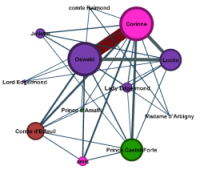Home page >
Data analysis >
Structured data analysis > Network analysis
Network analysis
Network analysis explores relationships and connections within a dataset. It has a longstanding tradition in the social sciences, but nowadays this analysis technique is also employed in humanities research. Network analysis often focuses on connections between persons (so-called social networks), but they may also be used to examine the relations between all kinds of objects, whereas topical networks deal with relations between themes and subjects in documents. Networks may also have a temporal and/or a spatial component.
 A network consists of so-called nodes and edges, where the nodes are the people and/or the objects while the edges are the links that show the relationships between the nodes. Relevant characteristics of the nodes are represented by so-called attributes. Attributes may vary from location (e.g. place of birth or a place from which a letter was sent) and personal characteristics (like gender or political affiliation) to participation of persons in certain events events or their involvement in an organisation. Quantitative aspects may be represented by the size of the nodes and/or the thickness of the links, in which case we speak of a weighted network. In a social network, for example, the thickness of the edge can indicate the intensity of the contacts between the persons. The links may also have directionality, indicating that there is a certain information flow from one node to the other (which is indicated by an arrow at the end of the edges). This visual representation of a dataset as a combination of nodes, attributes and edges, either directed or undirected or weighted or unweighted, may provide an insight into the data that would have been difficult to extract from the dataset as it is stored in one or more tables.
A network consists of so-called nodes and edges, where the nodes are the people and/or the objects while the edges are the links that show the relationships between the nodes. Relevant characteristics of the nodes are represented by so-called attributes. Attributes may vary from location (e.g. place of birth or a place from which a letter was sent) and personal characteristics (like gender or political affiliation) to participation of persons in certain events events or their involvement in an organisation. Quantitative aspects may be represented by the size of the nodes and/or the thickness of the links, in which case we speak of a weighted network. In a social network, for example, the thickness of the edge can indicate the intensity of the contacts between the persons. The links may also have directionality, indicating that there is a certain information flow from one node to the other (which is indicated by an arrow at the end of the edges). This visual representation of a dataset as a combination of nodes, attributes and edges, either directed or undirected or weighted or unweighted, may provide an insight into the data that would have been difficult to extract from the dataset as it is stored in one or more tables.
Examples
-
Cultural-historical research: Mapping The Republic of Letters
Digital visualisation of the correspondence networks of the intellectual community in the late 17th and 18th centuries in Europe and America.
-
Cultural-historical research: Six Degrees of Francis Bacon
A digital humanities project that recreates the British early modern social network to trace the personal relationships among figures like Bacon, Shakespeare, Isaac Newton and many others. The site currently (2017) identifies more than 13,000 individuals and highlights approximately 200,000 relationships.
-
Historical research: Rosey Pool
Rosey E. Pools networks for German-Jewish refugees in the 1930's.
-
Archaeological research: The Connected Caribbean

A socio-material approach to patterns of homogeneity and diversity in the pre-colonial period.
Tools
Key concepts of network analysis are relational databases, visualisation, quantitative data and statistics. There are numerous network analysis tools available. Roughly, there are two groups of tools: those which focus on visualisation and those which offer all kind of (statistical) analysis techniques as well, which may help in discovring all kinds of patterns and trends in the data. Two popular visualisation tools for humanities research are:
-
Gephi: by far the most popular network visualisation tool of recent years. It is a user-friendly program with a visually attractive design, which makes it a popular tool for humanities scholars. It is an open source program, which can be downloaded free of charge, for Windows, Mac and Linux. Various vidoe tutorials are available on YouTube and many plugins are avalaible for extra functionality, for example to connect information to geographical locations and export it to a digital map.
-
Nodegoat: a new tool of Dutch origin, which is web based and very user-friendly. It also has GIS functionality. You can create an account free of charge, see the nodegoat website. N.B. Because it is web based, you should be aware of the fact that your data reside on an external server, which may be undesirable in certain situations.
Two popular tools offering advanced analysis functionalities are:
-
UCINET: less fancy, but very powerful Windows based program, which offers many analytical network routines, network hypotheses testing procedures and general statistical and multivariate analytical tools. You can download a free trial version for 60 days, after which you have to buy a license.
-
Pajek: a free alternative for UCINET, offering extensive analyses and calculations. Particularly useful for large databases. Free download for Windows.
Further information
Introduction to social network methods (University of California) provides an introduction to the theory and practice of network analysis in the social sciences, which is also very useful for humanities scholars interested in social networks.
For a more in-depth introduction, you are referred to John Scott's book Social Network Analysis (3rd edition, 2012).
On his website Scott Weingart explains in a clear and accessible information how networks can be applied. (Tag: "networks demystified"; start at the bottom with the first blog: "Demystifying Networks: Part 1 of : An Introduction").
Stephen P Borgatti et al, Analyzing Social Networks (London 2013) is a practical book on how to collect, visualize, analyze and interpret social network data.
Patrick Jagoda, Networks in Literature and Media (Oxford Research Encyclopedias, 2017).
Historical Network Research: website about the latest developments and publications in this field. Also lists conferences and workshops. It also provides those new to network analysis with some helpful first information and publishes the Journal of Historical Network Research.
Historical DataNinjas: informal blog about the latest developments in the field of historical social network analysis.



